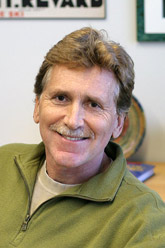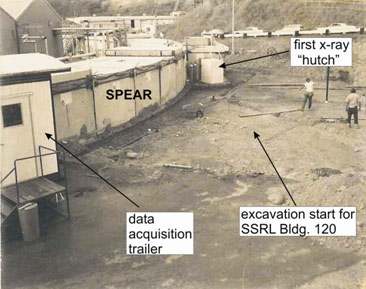
Handy Links
SLAC News Center
SLAC Today
- Subscribe
- Archives: Feb 2006-May 20, 2011
- Archives: May 23, 2011 and later
- Submit Feedback or Story Ideas
- About SLAC Today
SLAC News
Lab News
- Interactions
- Lightsources.org
- ILC NewsLine
- Int'l Science Grid This Week
- Fermilab Today
- Berkeley Lab News
- @brookhaven TODAY
- DOE Pulse
- CERN Courier
- DESY inForm
- US / LHC
SLAC Links
- Emergency
- Safety
- Policy Repository
- Site Entry Form

- Site Maps
- M & O Review
- Computing Status & Calendar
- SLAC Colloquium
- SLACspeak
- SLACspace
- SLAC Logo
- Café Menu
- Flea Market
- Web E-mail
- Marguerite Shuttle
- Discount Commuter Passes
-
Award Reporting Form
- SPIRES
- SciDoc
- Activity Groups
- Library
Stanford
Around the Bay
From the SSRL Director: From a Shed to a Directorate of SLAC
 Everybody at SLAC knows Pief Panofsky and other high energy physics and accelerator pioneers of the lab, but it is a safe bet that the history and pioneers of the Stanford Synchrotron Radiation Laboratory (SSRL) are less well known. Here I briefly want to tell how SSRL developed from a hole in the wall (of SPEAR) to an important part of SLAC. My story tries to capture the SSRL philosophy developed along the way and what it means today for implementing the vision of "one lab."
Everybody at SLAC knows Pief Panofsky and other high energy physics and accelerator pioneers of the lab, but it is a safe bet that the history and pioneers of the Stanford Synchrotron Radiation Laboratory (SSRL) are less well known. Here I briefly want to tell how SSRL developed from a hole in the wall (of SPEAR) to an important part of SLAC. My story tries to capture the SSRL philosophy developed along the way and what it means today for implementing the vision of "one lab."
Bill Spicer was a pioneer not just in his chosen field of photoemission research but as early as June 1968 wrote a letter to Pief Panofsky pointing out the possibility of using "cyclotron" radiation for solid state physics and chemistry. At the time, the construction of the Stanford Positron Electron Asymmetric Ring (SPEAR) was still on the drawing board, but Bill's vision soon became a reality with the advent of the storage ring SPEAR. Following his and Seb Doniach's initiative, with support of Pief Panofsky and the experimental facilities division of SLAC, the first X-ray "beam line" was constructed in 1972 by Ingolf Lindau and Piero Pianetta, a graduate student at the time. The picture below gives an idea of the humble beginnings of what was soon to be called the Stanford Synchrotron Radiation Project (SSRP), funded at the time by the National Science Foundation (Department of Energy funding started in 1983).
 Today SSRL is known in the X-ray community for its pioneering role in the development of synchrotron radiation techniques, instrumentation and forefront scientific research. Many of the leaders in X-ray science today honed their experimental skills at SSRP, which in 1977 became an Independent Laboratory of Stanford University under the name SSRL. The historical path toward the SSRL of today was all but smooth, and involved many heated discussions within its own management and staff to find and establish its identity, and the establishment of a user service model involved tough negotiations with users and institutions. It was only through these growing pains that the now widely accepted user service model of SSRL was developed under the leadership of SSRL Directors Artie Bienenstock and Keith Hodgson. The emphasis on the user as a "customer" and the goal of user satisfaction has shaped SSRL ever since and has served it well.
Today SSRL is known in the X-ray community for its pioneering role in the development of synchrotron radiation techniques, instrumentation and forefront scientific research. Many of the leaders in X-ray science today honed their experimental skills at SSRP, which in 1977 became an Independent Laboratory of Stanford University under the name SSRL. The historical path toward the SSRL of today was all but smooth, and involved many heated discussions within its own management and staff to find and establish its identity, and the establishment of a user service model involved tough negotiations with users and institutions. It was only through these growing pains that the now widely accepted user service model of SSRL was developed under the leadership of SSRL Directors Artie Bienenstock and Keith Hodgson. The emphasis on the user as a "customer" and the goal of user satisfaction has shaped SSRL ever since and has served it well.
Even after SSRL formally became a Division of SLAC in 1992, SSRL maintained considerable independence from "big brother" SLAC, despite relying on lab-wide services such as facilities, purchasing, human resources etc. The underlying operational philosophy was to make sure that SSRL controlled the resources required to assure reliable beam delivery to users, such as running and controlling the injector and SPEAR ring and assuming complete electrical, mechanical and computer support of beam lines and experimental stations. Because of the size of SSRL as an organization, its staff is largely organized in small groups and it is common for people to closely work together and assume multiple tasks. SSRL has thus benefited from the well-known effectiveness of highly interactive small teams, which in our case is based on the understanding, pride of ownership and execution of the customer driven service model.
The question arises how SSRL fits into the bigger model of "one lab," where planning beyond the divisional boundaries is necessary and where centralization of certain services can lead to additional opportunities and result in significant cost savings. We all know examples of centralized services that work and don't work. To some people at SSRL, the thought of a one-size-fits-all centralization is outright scary. This problem can only be solved if SSRL management and staff become part of finding the solution. It involves working closer together, getting to know each other better and establishing trust. The SSRL staff needs to keep an open mind to centralizing certain functions while existing central organizations at SLAC need to realize that certain SSRL functions cannot be centralized because they are the key to the success of our user service model. I, for one, am looking forward to the challenge.
—Joachim Stöhr, SLAC Today, February 1, 2008